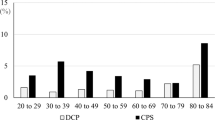Abstract
Predominant symptoms in prostate cancer patients are erectile dysfunctions and urinary problems. As decreases of these functions can be attributed to disease and treatment but also to age-related decreases, we conducted a study on a German reference population measuring general quality of life (QoL) as well as prostate-specific symptoms. In cooperation with a German health insurance company, 3000 questionnaires were mailed to a randomly selected sample of men aged 45–75 years. Questionnaires used were the EORTC QLQ-C30 and a prostate-specific module (PSM). One thousand one hundred and fifty questionnaires were returned (response rate: 37.6%). QoL data from this reference population were compared to QoL data from a historical cohort study of prostate cancer patients following either prostatectomy or radiotherapy. In terms of general QoL, the reference population showed similar QoL scores as prostatectomy patients, but better scores than radiotherapy patients. On the PSM, the reference sample showed better overall QoL, but a surprisingly high extent of erectile dysfunction, urinary problems and psychic strain. Taking into account the sensitive topic of this study (sexuality and urinary problems), the response rate is more than satisfying. Older men in our randomly selected, population-based sample do not show perfect erectile and urinary function. These findings should be considered when interpreting QoL data of prostate cancer patients.
This is a preview of subscription content, access via your institution
Access options
Subscribe to this journal
Receive 4 print issues and online access
$259.00 per year
only $64.75 per issue
Buy this article
- Purchase on Springer Link
- Instant access to full article PDF
Prices may be subject to local taxes which are calculated during checkout






Similar content being viewed by others
References
Arbeitsgemeinschaft Bevölkerungsbezogener Krebsregister in Zusammenarbeit mit dem Robert-Koch-Institut (Hrg.): Krebs in Deutschland- Häufigkeiten und Trends. 4. überarbeitete, aktualisierte Ausgabe, Saarbrücken, 2004.
Middleton RG, Thompson IM, Austenfeld MS, Cooner WH, Correa RJ, Gibbons RP et al. Prostate cancer clinical guidelines panel summary report on the management of clinically localized prostate cancer. The American Urological Association. J Urol 1995; 154: 2144–2148.
Potosky AL, Legler J, Albertsen PC, Stanford JL, Gilliland FD, Hamilton AS et al. Health outcomes after prostatectomy or radiotherapy for prostate cancer: results from the prostate cancer outcomes study. J Natl Cancer Inst 2000; 92: 1582–1592.
Aaronson NK, Ahmedzai S, Bergman B, Bullinger M, Cull A, Duez NJ et al. The European Organization for Research and Treatment of Cancer QLQ-C30: a quality-of-life instrument for use in international clinical trials in oncology. J Natl Cancer Inst 1993; 85: 365–376.
Fayers P, Aaronson N, Bjordal K, Curran D, Groenvold M, on behalf of the EORTC Quality of Life Study Group. Guidelines for Developing Questionnaire Modules. Quality of Life Study Group: Brussels, 1999.
Bestmann B, Rohde V, Siebmann JU, Galalae R, Weidner W, Küchler T . Validation of the German prostate specific module (PSM). World J Urol 2006; 19: 1–7.
Schwarz R, Hinz A . Reference data for the quality of life questionnaire EORTC-QLQ-C-30 in general German population. Eur J Cancer 2001; 37: 1345–1351.
D'Amico AV, Whittington R, Malkowicz SB, Weinstein M, Tomaszewski JE, Schultz D et al. Predicting prostate specific antigen outcome preoperatively in the prostate specific antigen era. J Urol 2001; 166: 2185–2188.
Osoba D, Rodrigues G, Myles J, Zee B, Pater J . Interpreting the significance of changes in health-related quality-of-life scores. J Clin Oncol 1998; 16: 139–144.
Litwin MS . Health related quality of life in older men without prostate cancer. J Urol 1999; 161: 1180–1184.
Hjermstad MJ, Fayers PM, Bjordal K, Kaasa S . Health-related quality of life in the general Norwegian population assessed by the European Organization for Research and Treatment of Cancer Core Quality-of-Life Questionnaire: the QLQ=C30 (+3). J Clin Oncol 1998; 16: 1188–1196.
Acknowledgements
This study was supported by grants from Takeda Pharma Inc. (Japan) and Sancura BKK (Germany).
Author information
Authors and Affiliations
Corresponding author
Rights and permissions
About this article
Cite this article
Bestmann, B., Loetters, C., Diemer, T. et al. Prostate-specific symptoms of prostate cancer in a German general population. Prostate Cancer Prostatic Dis 10, 52–59 (2007). https://doi.org/10.1038/sj.pcan.4500921
Received:
Revised:
Accepted:
Published:
Issue Date:
DOI: https://doi.org/10.1038/sj.pcan.4500921
Keywords
This article is cited by
-
Age-specific health-related quality of life in disease-free long-term prostate cancer survivors versus male population controls—results from a population-based study
Supportive Care in Cancer (2020)
-
Iodine-125 seed brachytherapy for early stage prostate cancer: a single-institution review
Radiation Oncology (2015)
-
Quality of life in partners of patients with localised prostate cancer
Quality of Life Research (2014)
-
Prostatakarzinom in der Routineversorgung
Der Urologe (2014)
-
Zeitlicher Verlauf der Lebensqualität nach Prostatakarzinom
Der Urologe (2012)



